Health Promotion and Obesity in Australia: A Pamphlet Analysis Report
VerifiedAdded on 2022/08/22
|8
|1578
|16
Report
AI Summary
This report analyzes an Australian health promotion pamphlet concerning obesity, examining its target audience, prevalence, and relevance to the community. The essay delves into the health message's importance, linking it to the Ottawa Charter's health promotion strategies, including enabling, mediating, and advocating for health. It discusses the risk factors associated with obesity, the government's initiatives, and the role of nurses, guided by NMBA codes, in addressing this public health issue through interventions such as nutritional advice, exercise encouragement, and education on obesity's health risks. The analysis highlights the application of these insights in future nursing practice, emphasizing patient care and health promotion.
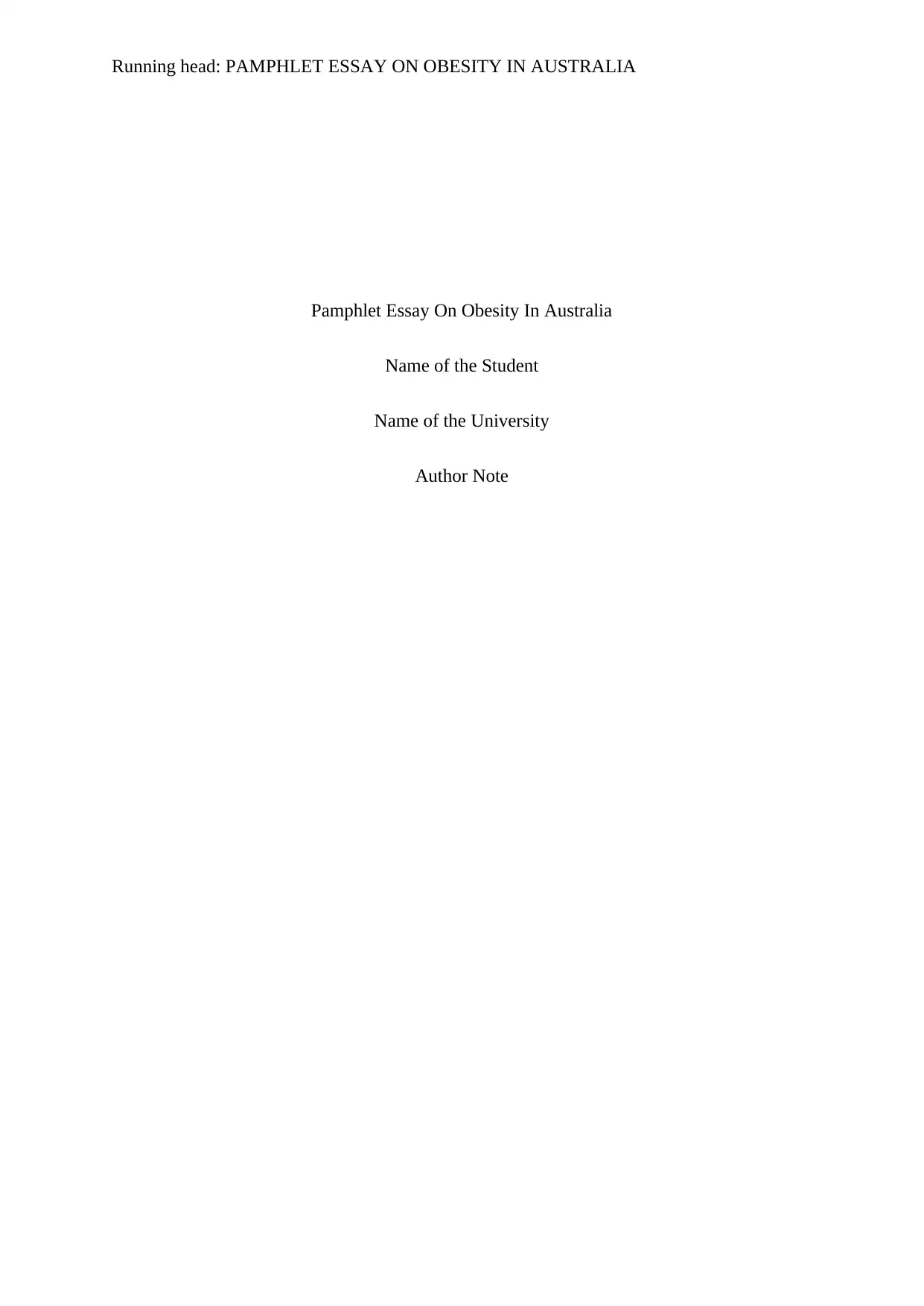
Running head: PAMPHLET ESSAY ON OBESITY IN AUSTRALIA
Pamphlet Essay On Obesity In Australia
Name of the Student
Name of the University
Author Note
Pamphlet Essay On Obesity In Australia
Name of the Student
Name of the University
Author Note
Paraphrase This Document
Need a fresh take? Get an instant paraphrase of this document with our AI Paraphraser
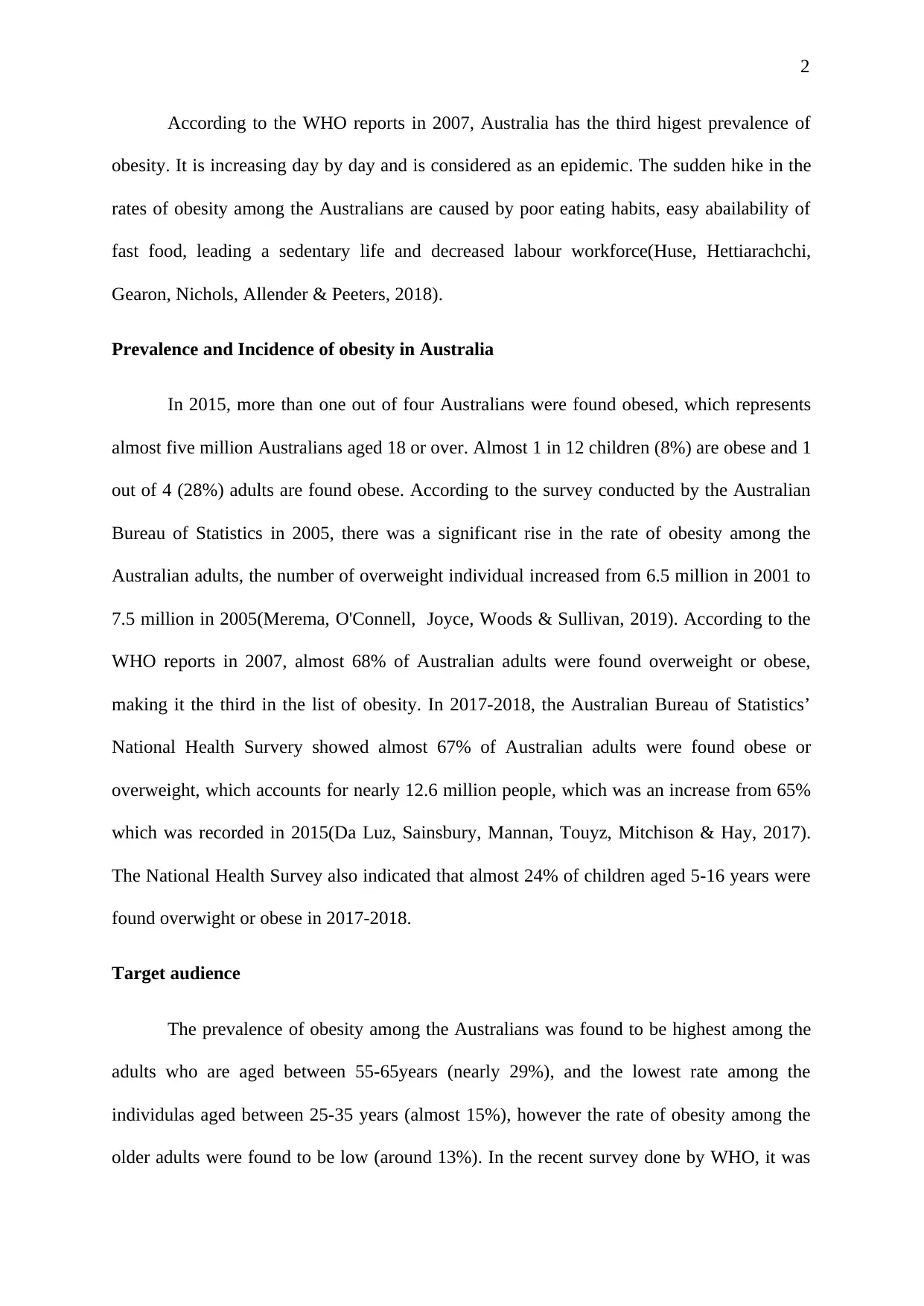
2
According to the WHO reports in 2007, Australia has the third higest prevalence of
obesity. It is increasing day by day and is considered as an epidemic. The sudden hike in the
rates of obesity among the Australians are caused by poor eating habits, easy abailability of
fast food, leading a sedentary life and decreased labour workforce(Huse, Hettiarachchi,
Gearon, Nichols, Allender & Peeters, 2018).
Prevalence and Incidence of obesity in Australia
In 2015, more than one out of four Australians were found obesed, which represents
almost five million Australians aged 18 or over. Almost 1 in 12 children (8%) are obese and 1
out of 4 (28%) adults are found obese. According to the survey conducted by the Australian
Bureau of Statistics in 2005, there was a significant rise in the rate of obesity among the
Australian adults, the number of overweight individual increased from 6.5 million in 2001 to
7.5 million in 2005(Merema, O'Connell, Joyce, Woods & Sullivan, 2019). According to the
WHO reports in 2007, almost 68% of Australian adults were found overweight or obese,
making it the third in the list of obesity. In 2017-2018, the Australian Bureau of Statistics’
National Health Survery showed almost 67% of Australian adults were found obese or
overweight, which accounts for nearly 12.6 million people, which was an increase from 65%
which was recorded in 2015(Da Luz, Sainsbury, Mannan, Touyz, Mitchison & Hay, 2017).
The National Health Survey also indicated that almost 24% of children aged 5-16 years were
found overwight or obese in 2017-2018.
Target audience
The prevalence of obesity among the Australians was found to be highest among the
adults who are aged between 55-65years (nearly 29%), and the lowest rate among the
individulas aged between 25-35 years (almost 15%), however the rate of obesity among the
older adults were found to be low (around 13%). In the recent survey done by WHO, it was
According to the WHO reports in 2007, Australia has the third higest prevalence of
obesity. It is increasing day by day and is considered as an epidemic. The sudden hike in the
rates of obesity among the Australians are caused by poor eating habits, easy abailability of
fast food, leading a sedentary life and decreased labour workforce(Huse, Hettiarachchi,
Gearon, Nichols, Allender & Peeters, 2018).
Prevalence and Incidence of obesity in Australia
In 2015, more than one out of four Australians were found obesed, which represents
almost five million Australians aged 18 or over. Almost 1 in 12 children (8%) are obese and 1
out of 4 (28%) adults are found obese. According to the survey conducted by the Australian
Bureau of Statistics in 2005, there was a significant rise in the rate of obesity among the
Australian adults, the number of overweight individual increased from 6.5 million in 2001 to
7.5 million in 2005(Merema, O'Connell, Joyce, Woods & Sullivan, 2019). According to the
WHO reports in 2007, almost 68% of Australian adults were found overweight or obese,
making it the third in the list of obesity. In 2017-2018, the Australian Bureau of Statistics’
National Health Survery showed almost 67% of Australian adults were found obese or
overweight, which accounts for nearly 12.6 million people, which was an increase from 65%
which was recorded in 2015(Da Luz, Sainsbury, Mannan, Touyz, Mitchison & Hay, 2017).
The National Health Survey also indicated that almost 24% of children aged 5-16 years were
found overwight or obese in 2017-2018.
Target audience
The prevalence of obesity among the Australians was found to be highest among the
adults who are aged between 55-65years (nearly 29%), and the lowest rate among the
individulas aged between 25-35 years (almost 15%), however the rate of obesity among the
older adults were found to be low (around 13%). In the recent survey done by WHO, it was
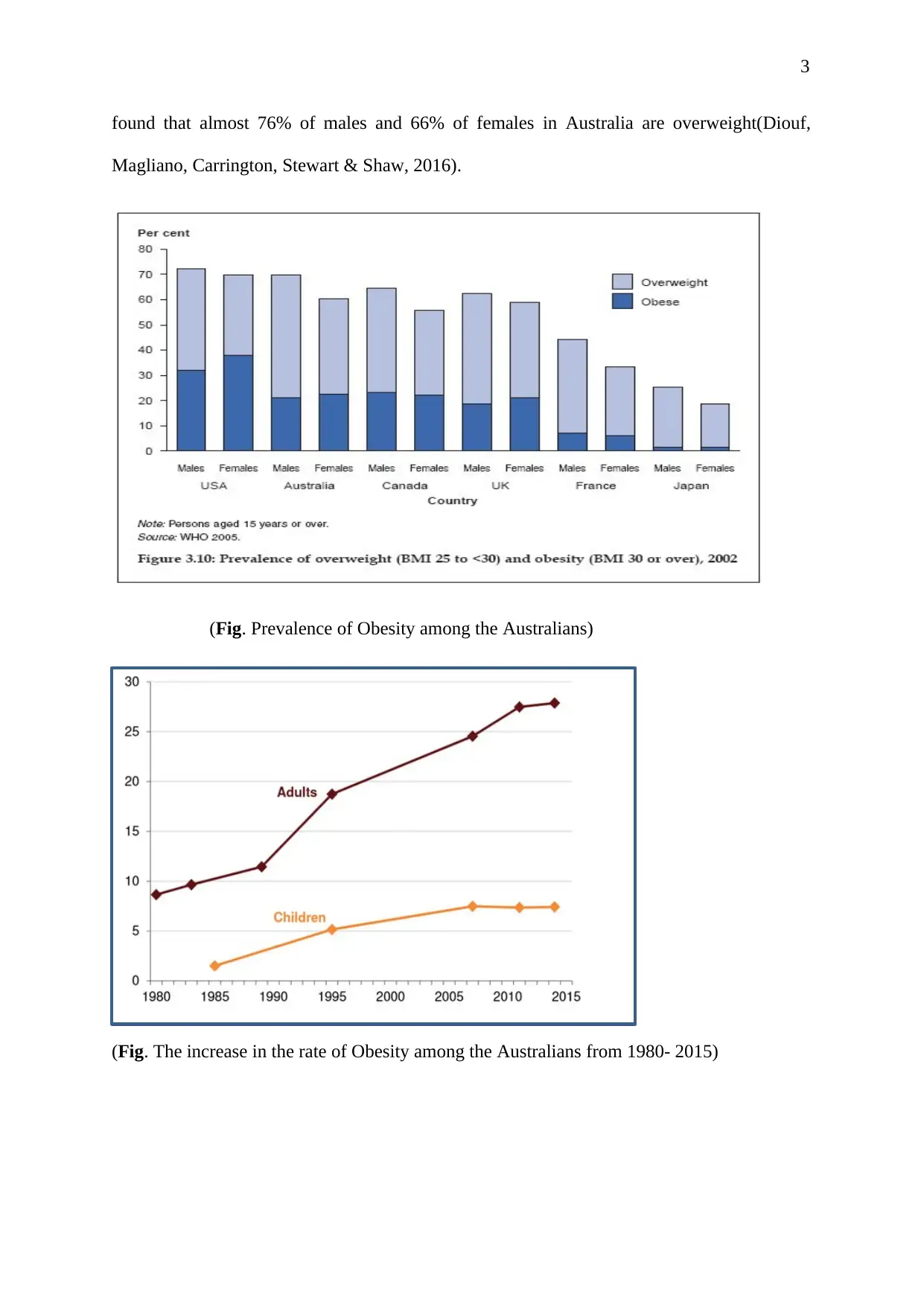
3
found that almost 76% of males and 66% of females in Australia are overweight(Diouf,
Magliano, Carrington, Stewart & Shaw, 2016).
(Fig. Prevalence of Obesity among the Australians)
(Fig. The increase in the rate of Obesity among the Australians from 1980- 2015)
found that almost 76% of males and 66% of females in Australia are overweight(Diouf,
Magliano, Carrington, Stewart & Shaw, 2016).
(Fig. Prevalence of Obesity among the Australians)
(Fig. The increase in the rate of Obesity among the Australians from 1980- 2015)
⊘ This is a preview!⊘
Do you want full access?
Subscribe today to unlock all pages.

Trusted by 1+ million students worldwide
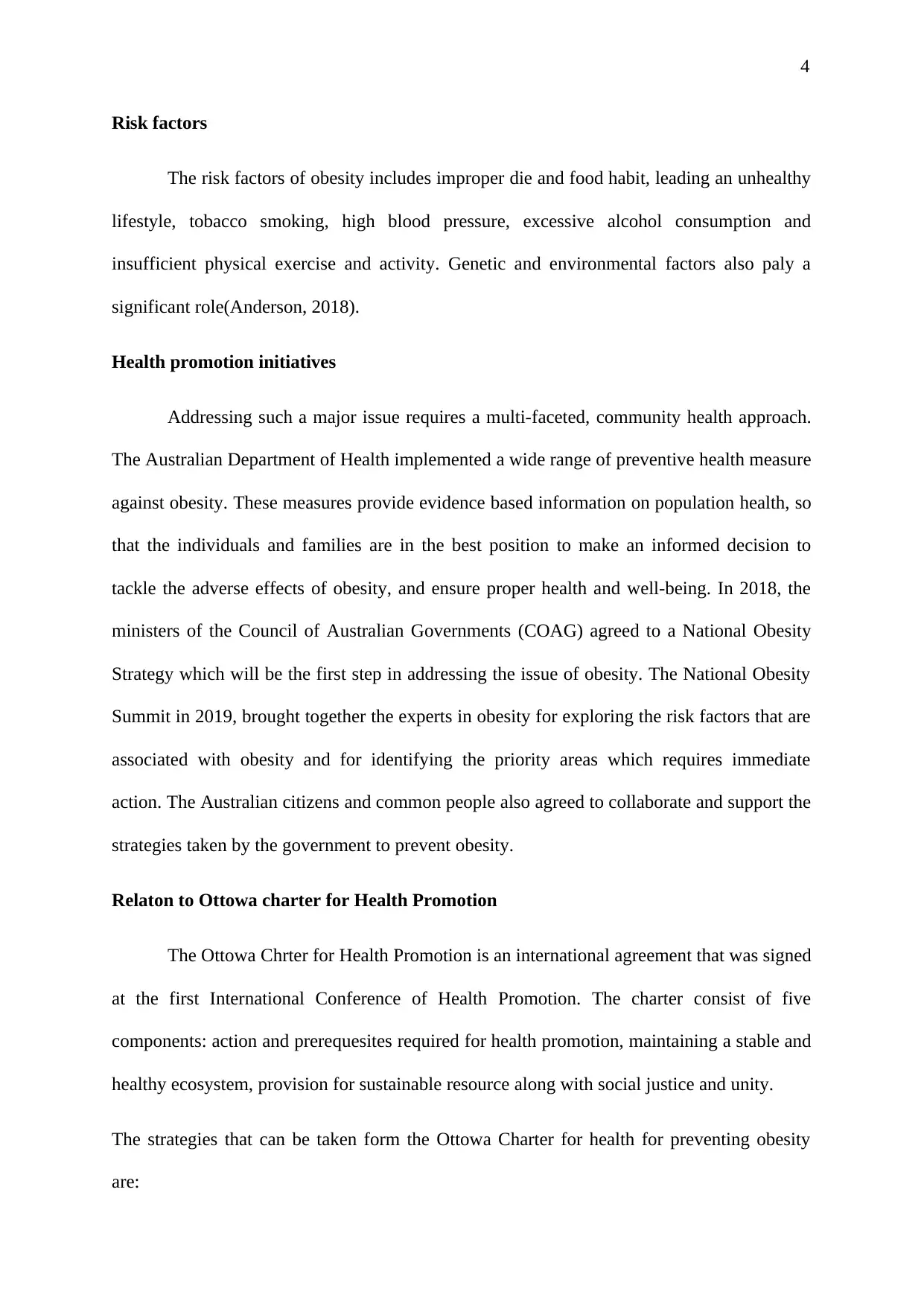
4
Risk factors
The risk factors of obesity includes improper die and food habit, leading an unhealthy
lifestyle, tobacco smoking, high blood pressure, excessive alcohol consumption and
insufficient physical exercise and activity. Genetic and environmental factors also paly a
significant role(Anderson, 2018).
Health promotion initiatives
Addressing such a major issue requires a multi-faceted, community health approach.
The Australian Department of Health implemented a wide range of preventive health measure
against obesity. These measures provide evidence based information on population health, so
that the individuals and families are in the best position to make an informed decision to
tackle the adverse effects of obesity, and ensure proper health and well-being. In 2018, the
ministers of the Council of Australian Governments (COAG) agreed to a National Obesity
Strategy which will be the first step in addressing the issue of obesity. The National Obesity
Summit in 2019, brought together the experts in obesity for exploring the risk factors that are
associated with obesity and for identifying the priority areas which requires immediate
action. The Australian citizens and common people also agreed to collaborate and support the
strategies taken by the government to prevent obesity.
Relaton to Ottowa charter for Health Promotion
The Ottowa Chrter for Health Promotion is an international agreement that was signed
at the first International Conference of Health Promotion. The charter consist of five
components: action and prerequesites required for health promotion, maintaining a stable and
healthy ecosystem, provision for sustainable resource along with social justice and unity.
The strategies that can be taken form the Ottowa Charter for health for preventing obesity
are:
Risk factors
The risk factors of obesity includes improper die and food habit, leading an unhealthy
lifestyle, tobacco smoking, high blood pressure, excessive alcohol consumption and
insufficient physical exercise and activity. Genetic and environmental factors also paly a
significant role(Anderson, 2018).
Health promotion initiatives
Addressing such a major issue requires a multi-faceted, community health approach.
The Australian Department of Health implemented a wide range of preventive health measure
against obesity. These measures provide evidence based information on population health, so
that the individuals and families are in the best position to make an informed decision to
tackle the adverse effects of obesity, and ensure proper health and well-being. In 2018, the
ministers of the Council of Australian Governments (COAG) agreed to a National Obesity
Strategy which will be the first step in addressing the issue of obesity. The National Obesity
Summit in 2019, brought together the experts in obesity for exploring the risk factors that are
associated with obesity and for identifying the priority areas which requires immediate
action. The Australian citizens and common people also agreed to collaborate and support the
strategies taken by the government to prevent obesity.
Relaton to Ottowa charter for Health Promotion
The Ottowa Chrter for Health Promotion is an international agreement that was signed
at the first International Conference of Health Promotion. The charter consist of five
components: action and prerequesites required for health promotion, maintaining a stable and
healthy ecosystem, provision for sustainable resource along with social justice and unity.
The strategies that can be taken form the Ottowa Charter for health for preventing obesity
are:
Paraphrase This Document
Need a fresh take? Get an instant paraphrase of this document with our AI Paraphraser
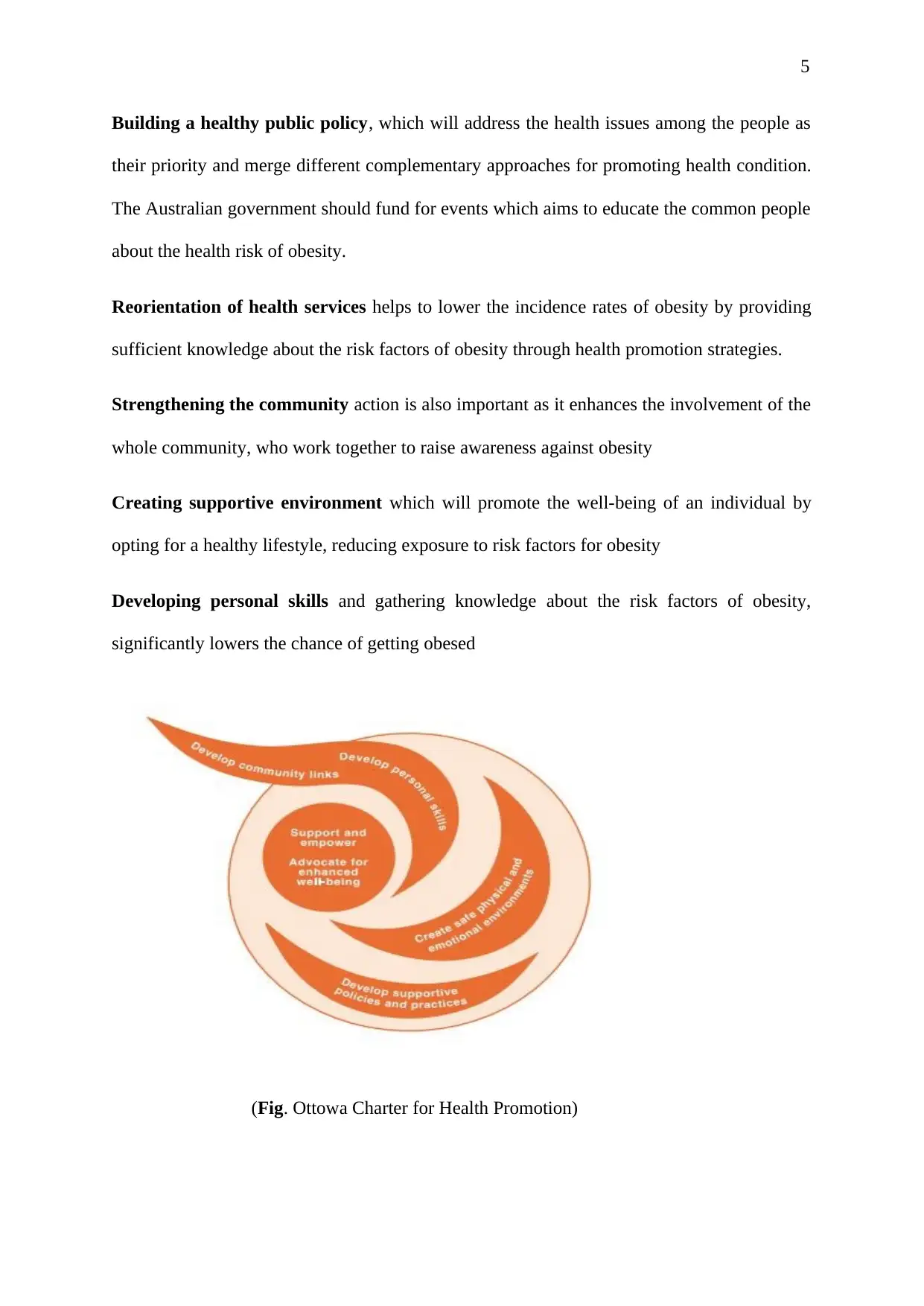
5
Building a healthy public policy, which will address the health issues among the people as
their priority and merge different complementary approaches for promoting health condition.
The Australian government should fund for events which aims to educate the common people
about the health risk of obesity.
Reorientation of health services helps to lower the incidence rates of obesity by providing
sufficient knowledge about the risk factors of obesity through health promotion strategies.
Strengthening the community action is also important as it enhances the involvement of the
whole community, who work together to raise awareness against obesity
Creating supportive environment which will promote the well-being of an individual by
opting for a healthy lifestyle, reducing exposure to risk factors for obesity
Developing personal skills and gathering knowledge about the risk factors of obesity,
significantly lowers the chance of getting obesed
(Fig. Ottowa Charter for Health Promotion)
Building a healthy public policy, which will address the health issues among the people as
their priority and merge different complementary approaches for promoting health condition.
The Australian government should fund for events which aims to educate the common people
about the health risk of obesity.
Reorientation of health services helps to lower the incidence rates of obesity by providing
sufficient knowledge about the risk factors of obesity through health promotion strategies.
Strengthening the community action is also important as it enhances the involvement of the
whole community, who work together to raise awareness against obesity
Creating supportive environment which will promote the well-being of an individual by
opting for a healthy lifestyle, reducing exposure to risk factors for obesity
Developing personal skills and gathering knowledge about the risk factors of obesity,
significantly lowers the chance of getting obesed
(Fig. Ottowa Charter for Health Promotion)
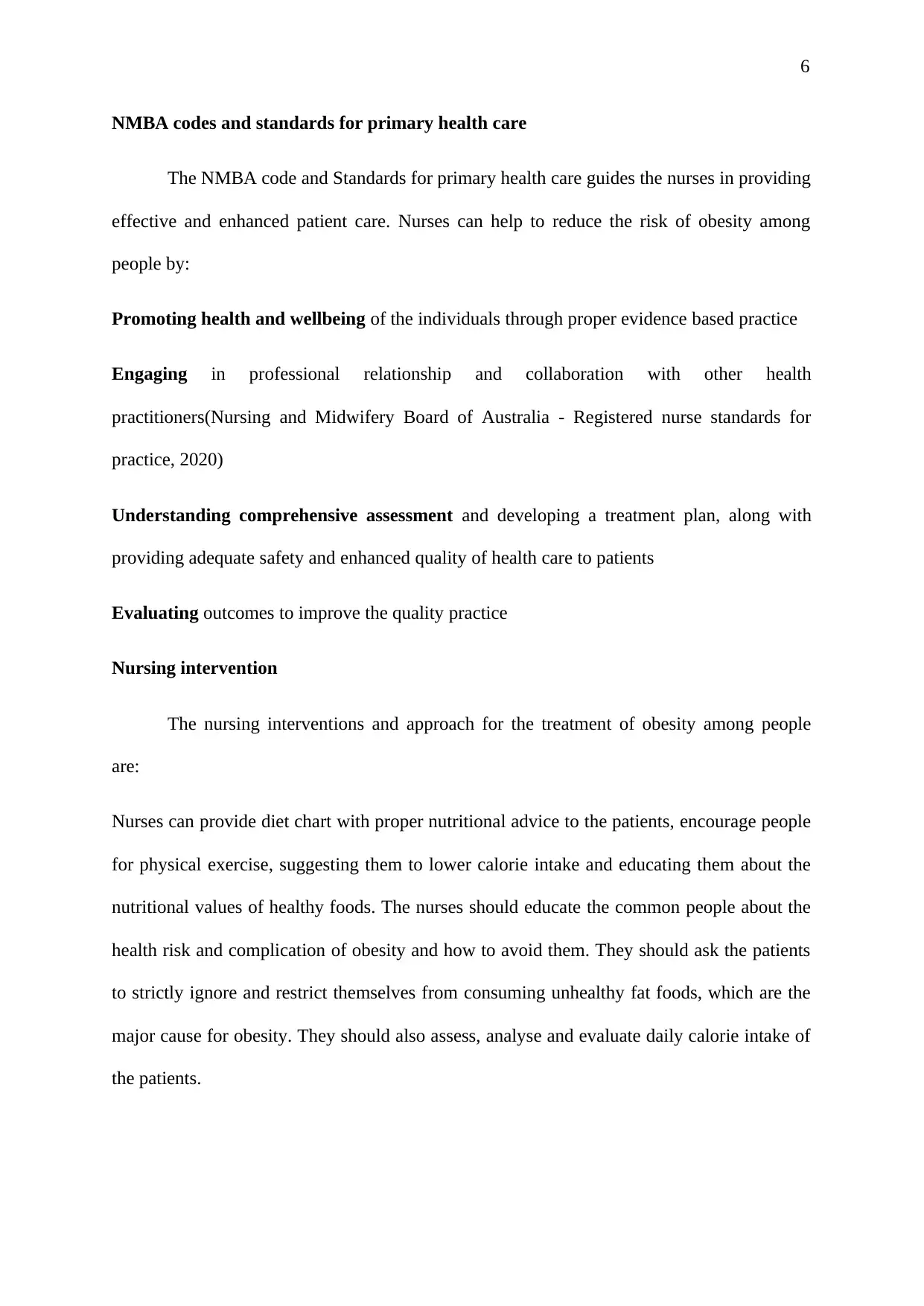
6
NMBA codes and standards for primary health care
The NMBA code and Standards for primary health care guides the nurses in providing
effective and enhanced patient care. Nurses can help to reduce the risk of obesity among
people by:
Promoting health and wellbeing of the individuals through proper evidence based practice
Engaging in professional relationship and collaboration with other health
practitioners(Nursing and Midwifery Board of Australia - Registered nurse standards for
practice, 2020)
Understanding comprehensive assessment and developing a treatment plan, along with
providing adequate safety and enhanced quality of health care to patients
Evaluating outcomes to improve the quality practice
Nursing intervention
The nursing interventions and approach for the treatment of obesity among people
are:
Nurses can provide diet chart with proper nutritional advice to the patients, encourage people
for physical exercise, suggesting them to lower calorie intake and educating them about the
nutritional values of healthy foods. The nurses should educate the common people about the
health risk and complication of obesity and how to avoid them. They should ask the patients
to strictly ignore and restrict themselves from consuming unhealthy fat foods, which are the
major cause for obesity. They should also assess, analyse and evaluate daily calorie intake of
the patients.
NMBA codes and standards for primary health care
The NMBA code and Standards for primary health care guides the nurses in providing
effective and enhanced patient care. Nurses can help to reduce the risk of obesity among
people by:
Promoting health and wellbeing of the individuals through proper evidence based practice
Engaging in professional relationship and collaboration with other health
practitioners(Nursing and Midwifery Board of Australia - Registered nurse standards for
practice, 2020)
Understanding comprehensive assessment and developing a treatment plan, along with
providing adequate safety and enhanced quality of health care to patients
Evaluating outcomes to improve the quality practice
Nursing intervention
The nursing interventions and approach for the treatment of obesity among people
are:
Nurses can provide diet chart with proper nutritional advice to the patients, encourage people
for physical exercise, suggesting them to lower calorie intake and educating them about the
nutritional values of healthy foods. The nurses should educate the common people about the
health risk and complication of obesity and how to avoid them. They should ask the patients
to strictly ignore and restrict themselves from consuming unhealthy fat foods, which are the
major cause for obesity. They should also assess, analyse and evaluate daily calorie intake of
the patients.
⊘ This is a preview!⊘
Do you want full access?
Subscribe today to unlock all pages.

Trusted by 1+ million students worldwide
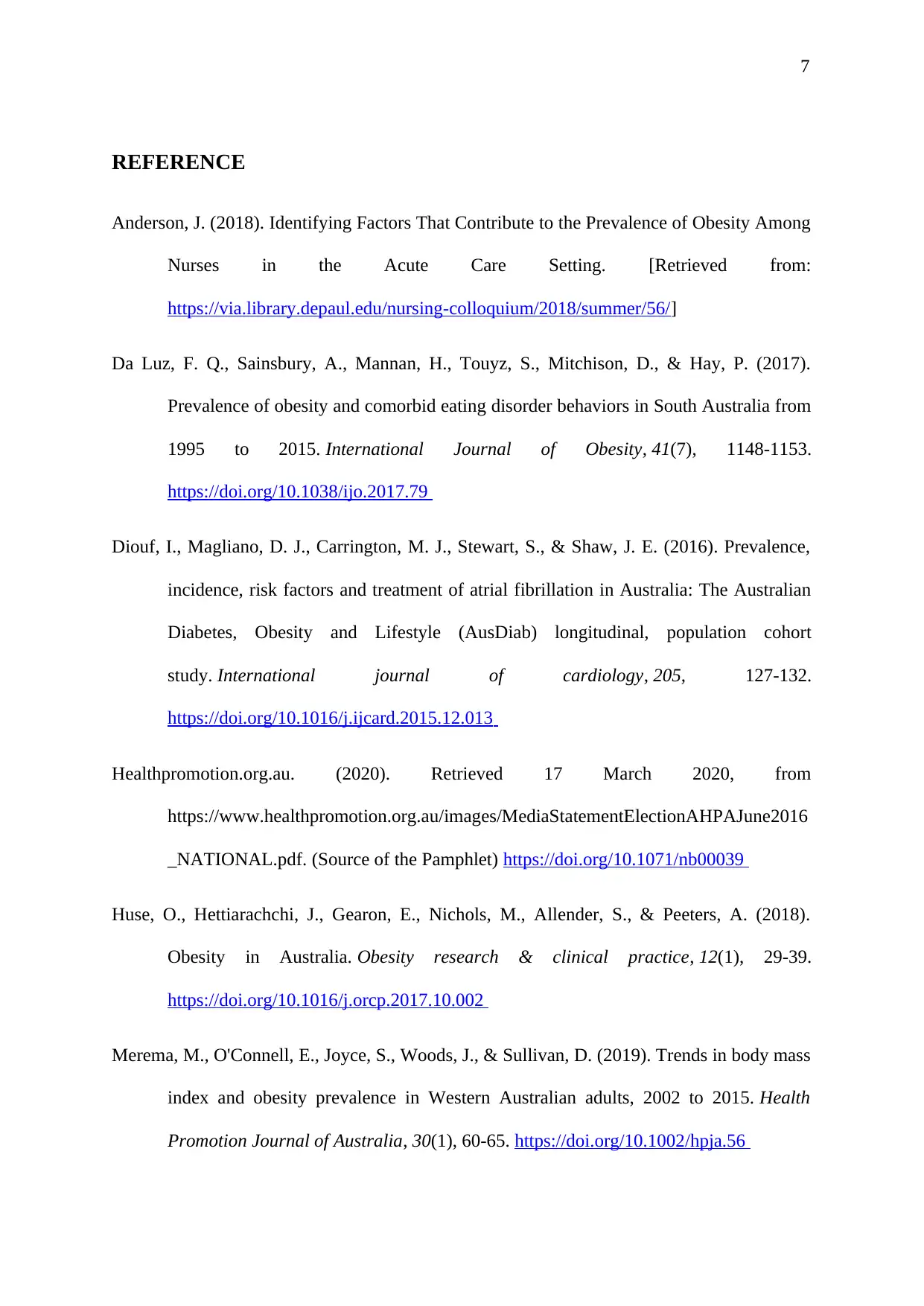
7
REFERENCE
Anderson, J. (2018). Identifying Factors That Contribute to the Prevalence of Obesity Among
Nurses in the Acute Care Setting. [Retrieved from:
https://via.library.depaul.edu/nursing-colloquium/2018/summer/56/]
Da Luz, F. Q., Sainsbury, A., Mannan, H., Touyz, S., Mitchison, D., & Hay, P. (2017).
Prevalence of obesity and comorbid eating disorder behaviors in South Australia from
1995 to 2015. International Journal of Obesity, 41(7), 1148-1153.
https://doi.org/10.1038/ijo.2017.79
Diouf, I., Magliano, D. J., Carrington, M. J., Stewart, S., & Shaw, J. E. (2016). Prevalence,
incidence, risk factors and treatment of atrial fibrillation in Australia: The Australian
Diabetes, Obesity and Lifestyle (AusDiab) longitudinal, population cohort
study. International journal of cardiology, 205, 127-132.
https://doi.org/10.1016/j.ijcard.2015.12.013
Healthpromotion.org.au. (2020). Retrieved 17 March 2020, from
https://www.healthpromotion.org.au/images/MediaStatementElectionAHPAJune2016
_NATIONAL.pdf. (Source of the Pamphlet) https://doi.org/10.1071/nb00039
Huse, O., Hettiarachchi, J., Gearon, E., Nichols, M., Allender, S., & Peeters, A. (2018).
Obesity in Australia. Obesity research & clinical practice, 12(1), 29-39.
https://doi.org/10.1016/j.orcp.2017.10.002
Merema, M., O'Connell, E., Joyce, S., Woods, J., & Sullivan, D. (2019). Trends in body mass
index and obesity prevalence in Western Australian adults, 2002 to 2015. Health
Promotion Journal of Australia, 30(1), 60-65. https://doi.org/10.1002/hpja.56
REFERENCE
Anderson, J. (2018). Identifying Factors That Contribute to the Prevalence of Obesity Among
Nurses in the Acute Care Setting. [Retrieved from:
https://via.library.depaul.edu/nursing-colloquium/2018/summer/56/]
Da Luz, F. Q., Sainsbury, A., Mannan, H., Touyz, S., Mitchison, D., & Hay, P. (2017).
Prevalence of obesity and comorbid eating disorder behaviors in South Australia from
1995 to 2015. International Journal of Obesity, 41(7), 1148-1153.
https://doi.org/10.1038/ijo.2017.79
Diouf, I., Magliano, D. J., Carrington, M. J., Stewart, S., & Shaw, J. E. (2016). Prevalence,
incidence, risk factors and treatment of atrial fibrillation in Australia: The Australian
Diabetes, Obesity and Lifestyle (AusDiab) longitudinal, population cohort
study. International journal of cardiology, 205, 127-132.
https://doi.org/10.1016/j.ijcard.2015.12.013
Healthpromotion.org.au. (2020). Retrieved 17 March 2020, from
https://www.healthpromotion.org.au/images/MediaStatementElectionAHPAJune2016
_NATIONAL.pdf. (Source of the Pamphlet) https://doi.org/10.1071/nb00039
Huse, O., Hettiarachchi, J., Gearon, E., Nichols, M., Allender, S., & Peeters, A. (2018).
Obesity in Australia. Obesity research & clinical practice, 12(1), 29-39.
https://doi.org/10.1016/j.orcp.2017.10.002
Merema, M., O'Connell, E., Joyce, S., Woods, J., & Sullivan, D. (2019). Trends in body mass
index and obesity prevalence in Western Australian adults, 2002 to 2015. Health
Promotion Journal of Australia, 30(1), 60-65. https://doi.org/10.1002/hpja.56
Paraphrase This Document
Need a fresh take? Get an instant paraphrase of this document with our AI Paraphraser
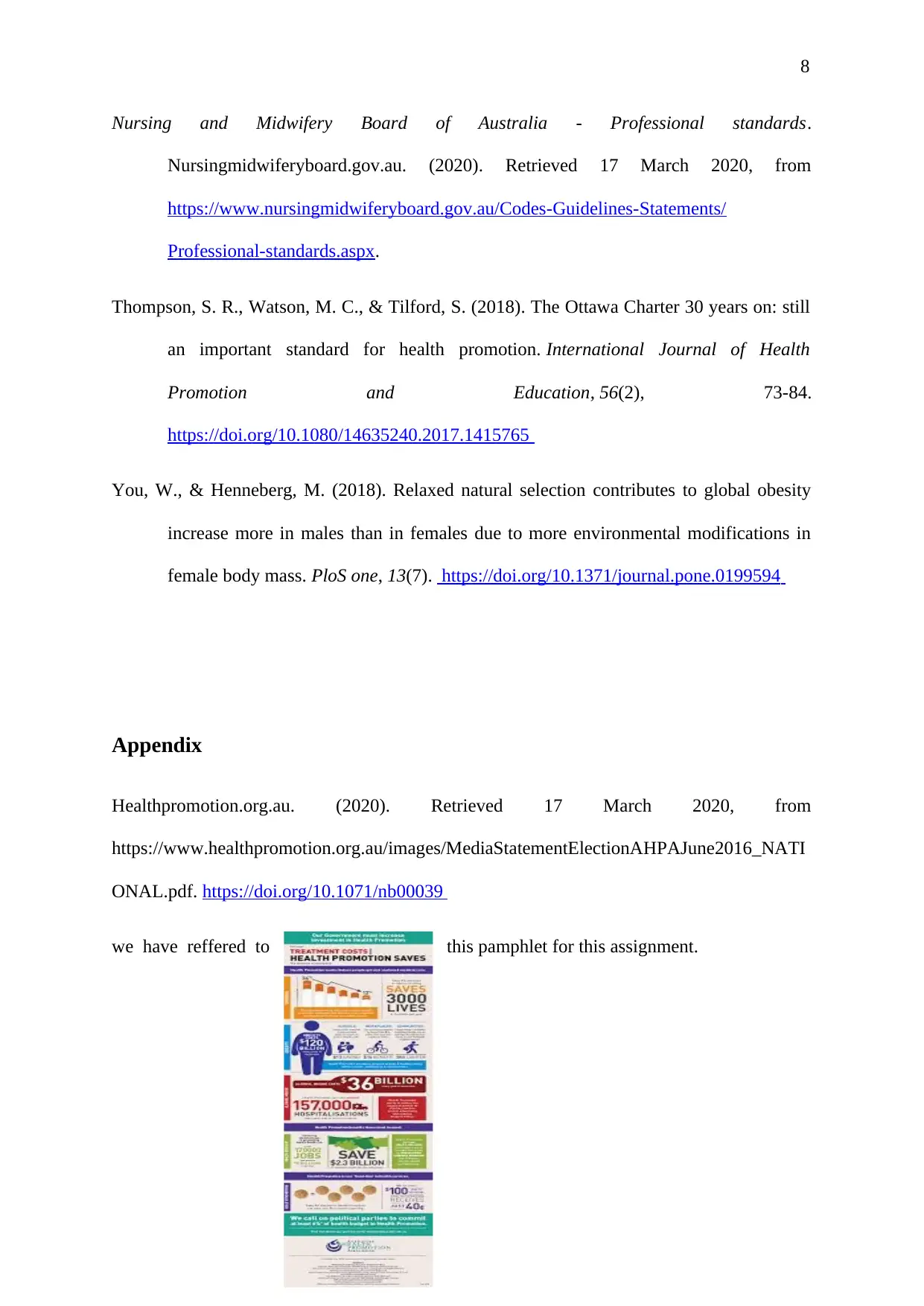
8
Nursing and Midwifery Board of Australia - Professional standards.
Nursingmidwiferyboard.gov.au. (2020). Retrieved 17 March 2020, from
https://www.nursingmidwiferyboard.gov.au/Codes-Guidelines-Statements/
Professional-standards.aspx.
Thompson, S. R., Watson, M. C., & Tilford, S. (2018). The Ottawa Charter 30 years on: still
an important standard for health promotion. International Journal of Health
Promotion and Education, 56(2), 73-84.
https://doi.org/10.1080/14635240.2017.1415765
You, W., & Henneberg, M. (2018). Relaxed natural selection contributes to global obesity
increase more in males than in females due to more environmental modifications in
female body mass. PloS one, 13(7). https://doi.org/10.1371/journal.pone.0199594
Appendix
Healthpromotion.org.au. (2020). Retrieved 17 March 2020, from
https://www.healthpromotion.org.au/images/MediaStatementElectionAHPAJune2016_NATI
ONAL.pdf. https://doi.org/10.1071/nb00039
we have reffered to this pamphlet for this assignment.
Nursing and Midwifery Board of Australia - Professional standards.
Nursingmidwiferyboard.gov.au. (2020). Retrieved 17 March 2020, from
https://www.nursingmidwiferyboard.gov.au/Codes-Guidelines-Statements/
Professional-standards.aspx.
Thompson, S. R., Watson, M. C., & Tilford, S. (2018). The Ottawa Charter 30 years on: still
an important standard for health promotion. International Journal of Health
Promotion and Education, 56(2), 73-84.
https://doi.org/10.1080/14635240.2017.1415765
You, W., & Henneberg, M. (2018). Relaxed natural selection contributes to global obesity
increase more in males than in females due to more environmental modifications in
female body mass. PloS one, 13(7). https://doi.org/10.1371/journal.pone.0199594
Appendix
Healthpromotion.org.au. (2020). Retrieved 17 March 2020, from
https://www.healthpromotion.org.au/images/MediaStatementElectionAHPAJune2016_NATI
ONAL.pdf. https://doi.org/10.1071/nb00039
we have reffered to this pamphlet for this assignment.
1 out of 8
Related Documents
Your All-in-One AI-Powered Toolkit for Academic Success.
+13062052269
info@desklib.com
Available 24*7 on WhatsApp / Email
![[object Object]](/_next/static/media/star-bottom.7253800d.svg)
Unlock your academic potential
Copyright © 2020–2025 A2Z Services. All Rights Reserved. Developed and managed by ZUCOL.





